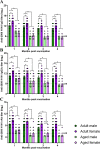Estradiol mediates greater germinal center responses to influenza vaccination in female than male mice
- PMID: 38441028
- PMCID: PMC11005424
- DOI: 10.1128/mbio.00326-24
Estradiol mediates greater germinal center responses to influenza vaccination in female than male mice
Abstract
Adult females of reproductive age develop greater antibody responses to inactivated influenza vaccines (IIV) than males. How sex, age, and sex steroid concentrations impact B cells and durability of IIV-induced immunity and protection over 4 months post-vaccination (mpv) was analyzed. Vaccinated adult females had greater germinal center B cell and plasmablast frequencies in lymphoid tissues, higher neutralizing antibody responses 1-4 mpv, and better protection against live H1N1 challenge than adult males. Aged mice, regardless of sex, had reduced B cell frequencies, less durable antibody responses, and inferior protection after challenge than adult mice, which correlated with diminished estradiol among aged females. To confirm that greater IIV-induced immunity was caused by sex hormones, four core genotype (FCG) mice were used, in which the testes-determining gene, Sry, was deleted from chromosome Y (ChrY) and transferred to Chr3 to separate gonadal sex (i.e., ovaries or testes) from sex chromosome complement (i.e., XX or XY complement). Vaccinated, gonadal female FCG mice (XXF and XYF) had greater numbers of B cells, higher antiviral antibody titers, and reduced pulmonary virus titers following live H1N1 challenge than gonadal FCG males (XYM and XXM). To establish that lower estradiol concentrations cause diminished immunity, adult and aged females received either a placebo or estradiol replacement therapy prior to IIV. Estradiol replacement significantly increased IIV-induced antibody responses and reduced morbidity after the H1N1 challenge among aged females. These data highlight that estradiol is a targetable mechanism mediating greater humoral immunity following vaccination among adult females.IMPORTANCEFemales of reproductive ages develop greater antibody responses to influenza vaccines than males. We hypothesized that female-biased immunity and protection against influenza were mediated by estradiol signaling in B cells. Using diverse mouse models ranging from advanced-age mice to transgenic mice that separate sex steroids from sex chromosome complement, those mice with greater concentrations of estradiol consistently had greater numbers of antibody-producing B cells in lymphoid tissue, higher antiviral antibody titers, and greater protection against live influenza virus challenge. Treatment of aged female mice with estradiol enhanced vaccine-induced immunity and protection against disease, suggesting that estradiol signaling in B cells is critical for improved vaccine outcomes in females.
Keywords: B-cell responses; influenza vaccines; neutralizing antibodies; plasmablast; sex steroids; somatic hypermutation.
Conflict of interest statement
The authors declare no conflict of interest.
Figures






Update of
-
Estradiol Mediates Greater Germinal Center Responses to Influenza Vaccination in Female than Male Mice.bioRxiv [Preprint]. 2023 Nov 27:2023.11.27.568847. doi: 10.1101/2023.11.27.568847. bioRxiv. 2023. Update in: mBio. 2024 Apr 10;15(4):e0032624. doi: 10.1128/mbio.00326-24. PMID: 38077071 Free PMC article. Updated. Preprint.
References
-
- Engler RJM, Nelson MR, Klote MM, VanRaden MJ, Huang C-Y, Cox NJ, Klimov A, Keitel WA, Nichol KL, Carr WW, Treanor JJ, Walter Reed Health Care System Influenza Vaccine Consortium . 2008. Half- vs full-dose trivalent inactivated influenza vaccine (2004-2005): age, dose, and sex effects on immune responses. Arch Intern Med 168:2405–2414. doi:10.1001/archinternmed.2008.513 - DOI - PubMed
-
- Furman D, Hejblum BP, Simon N, Jojic V, Dekker CL, Thiébaut R, Tibshirani RJ, Davis MM. 2014. Systems analysis of sex differences reveals an immunosuppressive role for testosterone in the response to influenza vaccination. Proc Natl Acad Sci U S A 111:869–874. doi:10.1073/pnas.1321060111 - DOI - PMC - PubMed
MeSH terms
Substances
Grants and funding
LinkOut - more resources
Full Text Sources
Medical
